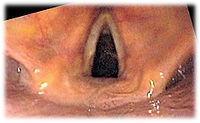
Photo from wikipedia
Background At present, artificial intelligence (AI) is incrementally used in clinical data analysis and clinical decision-making. Dental cusp angulation provide valuable insight into chewing efficiency and prosthesis safety issues. AI-enable… Click to show full abstract
Background At present, artificial intelligence (AI) is incrementally used in clinical data analysis and clinical decision-making. Dental cusp angulation provide valuable insight into chewing efficiency and prosthesis safety issues. AI-enable computing cusp angles have potential important value but there is no reliable digital measurement method at present. Objectives To establish a digital method for measuring cusp angles and investigate the inter-rater and intra-rater reliability. Methods Two cusp angles (angle α and angle β) of the first molar were measured on 21 plaster casts using a goniometer, and on their corresponding digital models using PicPick software after scanning with a CEREC Bluecam three-dimensional (3D) intraoral scanner. Means±standard deviations as well as intraclass correlation coefficients (ICCs) and Pearson's correlation coefficients (PCCs) were calculated and paired sample t-test was carried out. Results Angle α was 139.19°±13.86°, angle β was 19.25°±6.86°. A very strong positive correlation between the two methods was found when the examiner was experienced (r>0.914; p<0.05), and no significant difference between the two methods was found using the paired sample t-test (p>0.20). For inter-rater and intra-rater assessments, the PCC and ICC of the cusp angulation using the digital method showed that 15 of 16 values were higher than the corresponding values measured on traditional plaster casts. However, both measurement methods showed weak positive correlation (r<0.501) and significant differences (p=0.00) for repeated measurements of angle β at two different time points by an inexperienced examiner. Conclusionss Cusp angulation using 3D digital models was a clinical option and appeared to improve the reliability of cusp angulation compared with measuring plaster casts using a goniometer. Intra-rater variability was still evident in measuring small cusp angles using the digital model.
Journal Title: Methods of information in medicine
Year Published: 2022
Link to full text (if available)
Share on Social Media: Sign Up to like & get
recommendations!